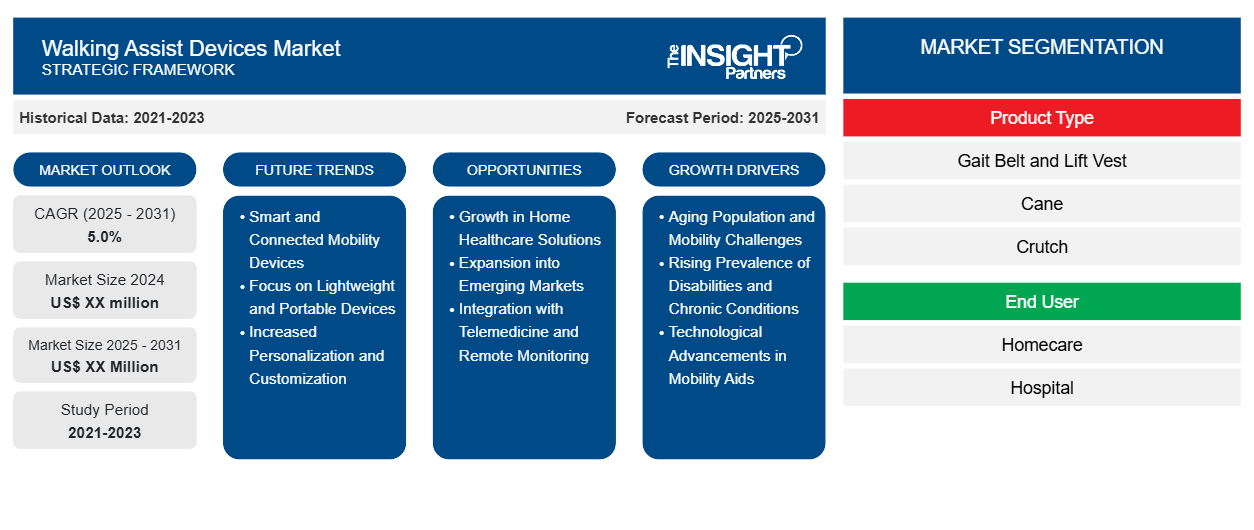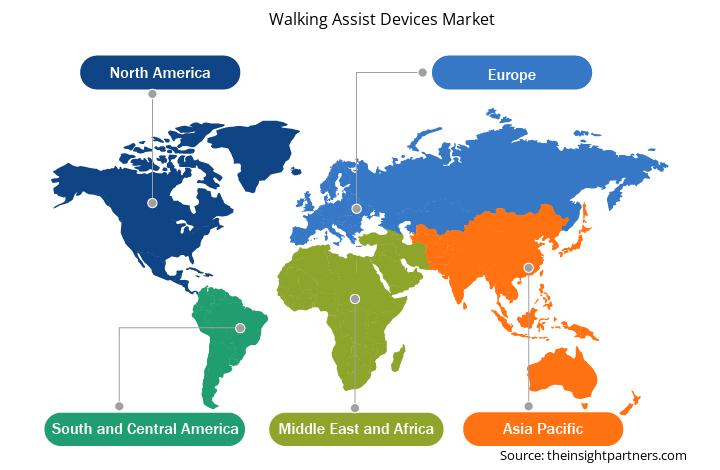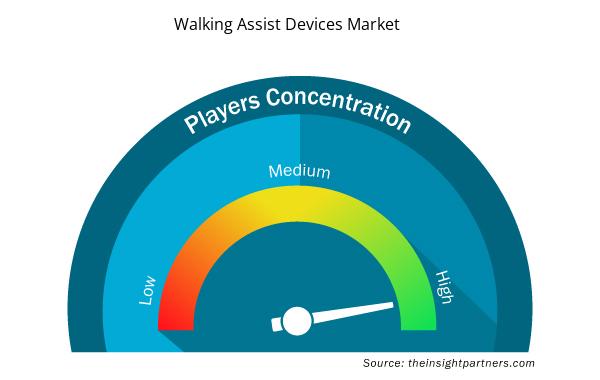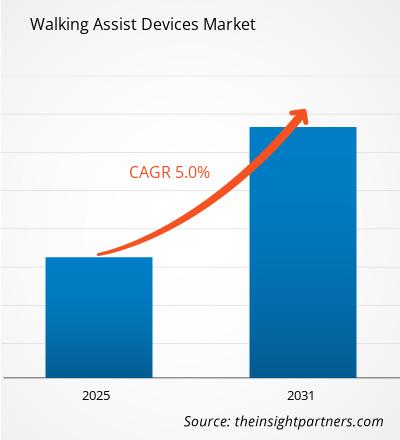The Walking Assist Devices Market is expected to register a CAGR of 5.0% from 2025 to 2031, with a market size expanding from US$ XX million in 2024 to US$ XX Million by 2031.
The report is segmented by Product Type (Gait Belt and Lift Vest, Cane, Crutch, Walker, Wheelchair, and Power Scooter). The report further presents analysis based on the End User( Homecare, Hospital, and Others). The global analysis is further broken-down at regional level and major countries. The Report Offers the Value in USD for the above analysis and segments.
Purpose of the Report
The report Walking Assist Devices Market by The Insight Partners aims to describe the present landscape and future growth, top driving factors, challenges, and opportunities. This will provide insights to various business stakeholders, such as:
- Technology Providers/Manufacturers: To understand the evolving market dynamics and know the potential growth opportunities, enabling them to make informed strategic decisions.
- Investors: To conduct a comprehensive trend analysis regarding the market growth rate, market financial projections, and opportunities that exist across the value chain.
- Regulatory bodies: To regulate policies and police activities in the market with the aim of minimizing abuse, preserving investor trust and confidence, and upholding the integrity and stability of the market.
Walking Assist Devices Market Segmentation
Product Type
- Gait Belt and Lift Vest
- Cane
- Crutch
- Walker
- Wheelchair
- Power Scooter
End User
- Homecare
- Hospital
Customize This Report To Suit Your Requirement
You will get customization on any report - free of charge - including parts of this report, or country-level analysis, Excel Data pack, as well as avail great offers and discounts for start-ups & universities
Walking Assist Devices Market: Strategic Insights

- Get Top Key Market Trends of this report.This FREE sample will include data analysis, ranging from market trends to estimates and forecasts.
Walking Assist Devices Market Growth Drivers
- Aging Population and Mobility Challenges: The growing elderly population worldwide, particularly in developed nations, is a major driver of the walking assist devices market. Older adults often face mobility challenges due to age-related conditions such as arthritis, osteoporosis, and Parkinson’s disease, increasing the demand for walking aids like walkers, canes, and rollators to enhance mobility and independence.
- Rising Prevalence of Disabilities and Chronic Conditions: Chronic conditions such as stroke, neurological disorders, and musculoskeletal diseases contribute to the rising demand for walking assist devices. As the number of individuals with disabilities increases, the market for walking aids expands, with patients seeking solutions to improve mobility, balance, and overall quality of life.
- Technological Advancements in Mobility Aids: Technological innovations in walking assist devices, such as motorized walkers, smart canes, and exoskeletons, are contributing to market growth. These devices incorporate features like sensors, GPS, and automatic adjustments, improving mobility assistance for individuals with varying levels of disability or mobility impairment.
Walking Assist Devices Market Future Trends
- Smart and Connected Mobility Devices: The integration of IoT and smart technologies in walking assist devices is a growing trend. Smart canes, walkers, and rollators with built-in sensors, GPS, and health-monitoring features allow users to track their movement and health metrics. These connected devices offer real-time data, enhancing user safety and enabling healthcare providers to monitor patients remotely.
- Focus on Lightweight and Portable Devices: Consumers are increasingly seeking lightweight, foldable, and easy-to-carry walking assist devices. Portable and compact devices are becoming more popular due to their convenience and practicality, especially for individuals who travel frequently or need a device that can be easily stored when not in use.
- Increased Personalization and Customization: There is a growing demand for walking assist devices that are customizable to meet individual user needs. Adjustable handles, seat options, and height settings allow users to personalize their devices for optimal comfort, while designs that blend with personal preferences are gaining traction.
Walking Assist Devices Market Opportunities
- Growth in Home Healthcare Solutions: The increasing shift towards home healthcare presents significant growth opportunities for walking assist devices. As more people opt for home-based rehabilitation and care, the demand for mobility aids and walking devices to support recovery and improve daily activities is expected to rise.
- Expansion into Emerging Markets: Emerging markets, especially in Asia-Pacific and Latin America, present significant opportunities due to growing healthcare infrastructure and the rising elderly population. The demand for affordable and effective walking assist devices is increasing, creating opportunities for manufacturers to expand their presence in these regions.
- Integration with Telemedicine and Remote Monitoring: There is an opportunity to integrate walking assist devices with telemedicine platforms to offer remote monitoring. Healthcare providers can track patient movement, monitor recovery progress, and intervene when necessary, providing a more comprehensive approach to rehabilitation and elderly care.
Walking Assist Devices Market Regional Insights
The regional trends and factors influencing the Walking Assist Devices Market throughout the forecast period have been thoroughly explained by the analysts at Insight Partners. This section also discusses Walking Assist Devices Market segments and geography across North America, Europe, Asia Pacific, Middle East and Africa, and South and Central America.

- Get the Regional Specific Data for Walking Assist Devices Market
Walking Assist Devices Market Report Scope
| Report Attribute | Details |
|---|---|
| Market size in 2024 | US$ XX million |
| Market Size by 2031 | US$ XX Million |
| Global CAGR (2025 - 2031) | 5.0% |
| Historical Data | 2021-2023 |
| Forecast period | 2025-2031 |
| Segments Covered |
By Product Type
|
| Regions and Countries Covered | North America
|
| Market leaders and key company profiles |
Walking Assist Devices Market Players Density: Understanding Its Impact on Business Dynamics
The Walking Assist Devices Market market is growing rapidly, driven by increasing end-user demand due to factors such as evolving consumer preferences, technological advancements, and greater awareness of the product's benefits. As demand rises, businesses are expanding their offerings, innovating to meet consumer needs, and capitalizing on emerging trends, which further fuels market growth.
Market players density refers to the distribution of firms or companies operating within a particular market or industry. It indicates how many competitors (market players) are present in a given market space relative to its size or total market value.
Major Companies operating in the Walking Assist Devices Market are:
- Drive DeVilbiss Healthcare
- Invacare Corporation
- Ossur
- Karman Healthcare
- Cardinal Health
- Human Care HC AB
Disclaimer: The companies listed above are not ranked in any particular order.

- Get the Walking Assist Devices Market top key players overview
Key Selling Points
- Comprehensive Coverage: The report comprehensively covers the analysis of products, services, types, and end users of the Walking Assist Devices Market, providing a holistic landscape.
- Expert Analysis: The report is compiled based on the in-depth understanding of industry experts and analysts.
- Up-to-date Information: The report assures business relevance due to its coverage of recent information and data trends.
- Customization Options: This report can be customized to cater to specific client requirements and suit the business strategies aptly.
The research report on the Walking Assist Devices Market can, therefore, help spearhead the trail of decoding and understanding the industry scenario and growth prospects. Although there can be a few valid concerns, the overall benefits of this report tend to outweigh the disadvantages.
- Historical Analysis (2 Years), Base Year, Forecast (7 Years) with CAGR
- PEST and SWOT Analysis
- Market Size Value / Volume - Global, Regional, Country
- Industry and Competitive Landscape
- Excel Dataset



Report Coverage
Revenue forecast, Company Analysis, Industry landscape, Growth factors, and Trends

Segment Covered
This text is related
to segments covered.

Regional Scope
North America, Europe, Asia Pacific, Middle East & Africa, South & Central America

Country Scope
This text is related
to country scope.
Frequently Asked Questions
The aging population, rising incidence of chronic conditions, and increased focus on improving quality of life for individuals with mobility impairments are key drivers of demand for walking assist devices. Technological advancements in mobility aids further fuel market growth.
Smart walking assist devices allow users to monitor their health metrics and track movement via sensors and GPS. This technology not only improves safety by alerting caregivers in emergencies but also offers real-time feedback for better mobility management and rehabilitation.
Despite growing demand, the market faces challenges such as the high cost of advanced devices, limited awareness in emerging markets, and the need for healthcare providers to offer proper training on device usage, especially for older adults with limited technological familiarity.
Lightweight, foldable, and easy-to-carry devices are highly sought after for their practicality, particularly for individuals who travel or need mobility aids for temporary or long-term use. The growing demand for portable solutions is pushing manufacturers to innovate with more compact, versatile designs.
The elderly population in emerging markets is rapidly increasing, driving demand for affordable and effective mobility aids. As healthcare infrastructure improves, the adoption of walking assist devices in these regions is expected to grow, offering significant growth opportunities for device manufacturers.
Telemedicine platforms offer the opportunity to monitor patients remotely, track mobility data, and offer continuous rehabilitation support. Integration of walking assist devices with telemedicine can improve patient outcomes, provide real-time feedback, and enhance the overall management of mobility impairments.
Trends and growth analysis reports related to Life Sciences : READ MORE..
- Drive DeVilbiss Healthcare
- Invacare Corporation
- Ossur
- Karman Healthcare
- Cardinal Health
- Human Care HC AB
- Pride Mobility Products Corporation
- Sunrise Medical
- GF Health Products
- Hollister Incorporated

 Get Free Sample For
Get Free Sample For